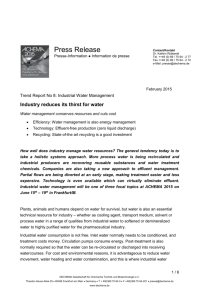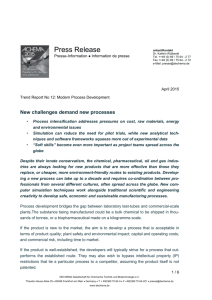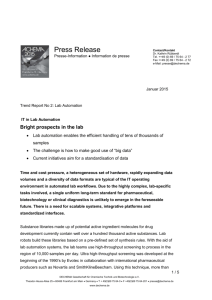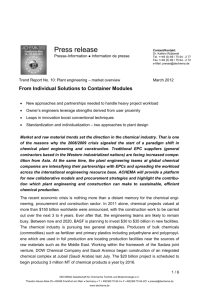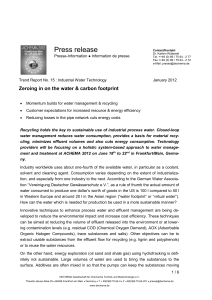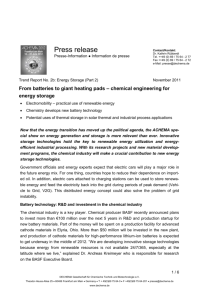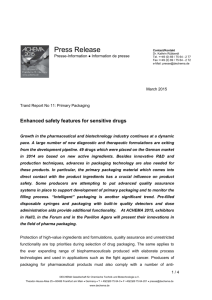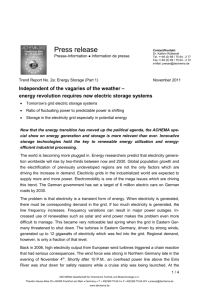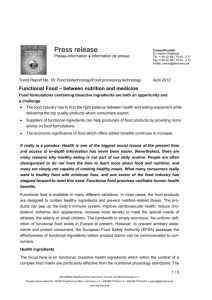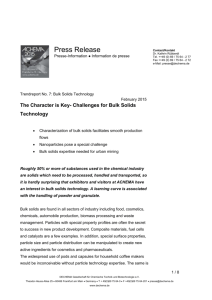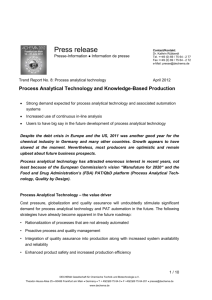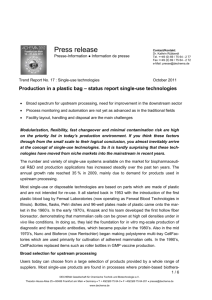doc - Achema
advertisement
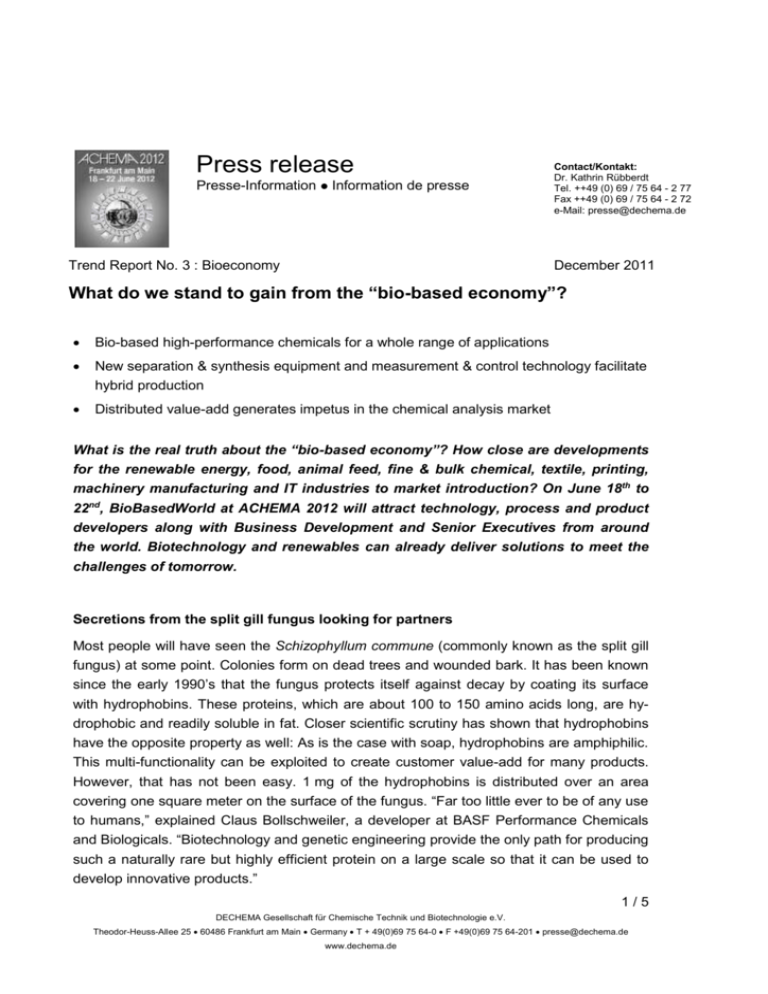
Press release Presse-Information Information de presse Trend Report No. 3 : Bioeconomy Contact/Kontakt: Dr. Kathrin Rübberdt Tel. ++49 (0) 69 / 75 64 - 2 77 Fax ++49 (0) 69 / 75 64 - 2 72 e-Mail: presse@dechema.de December 2011 What do we stand to gain from the “bio-based economy”? Bio-based high-performance chemicals for a whole range of applications New separation & synthesis equipment and measurement & control technology facilitate hybrid production Distributed value-add generates impetus in the chemical analysis market What is the real truth about the “bio-based economy”? How close are developments for the renewable energy, food, animal feed, fine & bulk chemical, textile, printing, machinery manufacturing and IT industries to market introduction? On June 18th to 22nd, BioBasedWorld at ACHEMA 2012 will attract technology, process and product developers along with Business Development and Senior Executives from around the world. Biotechnology and renewables can already deliver solutions to meet the challenges of tomorrow. Secretions from the split gill fungus looking for partners Most people will have seen the Schizophyllum commune (commonly known as the split gill fungus) at some point. Colonies form on dead trees and wounded bark. It has been known since the early 1990’s that the fungus protects itself against decay by coating its surface with hydrophobins. These proteins, which are about 100 to 150 amino acids long, are hydrophobic and readily soluble in fat. Closer scientific scrutiny has shown that hydrophobins have the opposite property as well: As is the case with soap, hydrophobins are amphiphilic. This multi-functionality can be exploited to create customer value-add for many products. However, that has not been easy. 1 mg of the hydrophobins is distributed over an area covering one square meter on the surface of the fungus. “Far too little ever to be of any use to humans,” explained Claus Bollschweiler, a developer at BASF Performance Chemicals and Biologicals. “Biotechnology and genetic engineering provide the only path for producing such a naturally rare but highly efficient protein on a large scale so that it can be used to develop innovative products.” 1/5 DECHEMA Gesellschaft für Chemische Technik und Biotechnologie e.V. Theodor-Heuss-Allee 25 60486 Frankfurt am Main Germany T + 49(0)69 75 64-0 F +49(0)69 75 64-201 presse@dechema.de www.dechema.de Genetic engineering techniques and fermentation have only recently made it feasible to produce hydrophobins by the ton. Functional coatings on construction materials are the initial applications including water-repellent insulating foam and silicon sealant which can be painted over. The silicon will only absorb paint once the surface has been treated with the fungus protein. The application spectrum for new product development is as broad as it is open. The fungus proteins could potentially be used in cosmetics for skin rehydration or in fur coloring products for pedigree dogs and cats. This would be done by linking them to keratin-binding natural or synthetic polypeptides. These hydrophobins might also help achieve functional improvements in pharmaceuticals, textiles and aquaculture feed. Hydrophobins are expected to play a significant role in the chemical production of thermoplastic particles where static charge on polystyrene foam continues to cause problems. The current approach is to prevent the problem by coating the particles, but the particles tend to stick together when conventional techniques are used, which impairs pourability. There is virtually no limit to the possible applications for these and other natural substances (e.g. succinic acid and microbial fuel cells) produced with the aid of biotechnology. The same applies to many other precursors and intermediates which the biotech industry is currently introducing. However, in the final analysis, the applications are customer driven. Developers that produce biotech products on an industrial scale must establish contact with the companies (in many cases SMEs) which are able to use them for their special applications. Even the secretions of the split gill have to find partners that have an in-depth understanding of their products, niche markets and end users but are not sufficiently aware of the business opportunities which new developments in biotechnology can offer away from the media paths. Intelligent devices and process technologies for parallel and alternating mode systems Forced to deal with commodity market volatility, non-payment risks, financial crises, new trade barriers in agricultural and food markets and regulatory conflicts relating to genetically modified plants, companies are noticeably reluctant to abandon so far reliable sources of raw materials, replace equipment that works reliably, modify production processes to handle new materials or build new systems from scratch based on new technologies. Investment – yes, technology revolution – no; me-too products – no, something new – yes, say the decision-makers. As a result, the preference is for components, modules, process solutions and systems which are able to accommodate different raw materials to produce the same end product and which are suitable for small test series. The expectations of what biotechnology should deliver are high: 2/5 DECHEMA Gesellschaft für Chemische Technik und Biotechnologie e.V. Theodor-Heuss-Allee 25 60486 Frankfurt am Main Germany T + 49(0)69 75 64-0 F +49(0)69 75 64-201 presse@dechema.de www.dechema.de Zero waste, utilization of byproducts Ability to process heterogeneous raw materials and input chemicals to produce the same end products Changeover during production of multiple products without interruption Utilization of existing infrastructure Up to this point, there have been few biotech solutions outside of the pharmaceutical industry, which have been affordable and have met expectations on a large scale. That is due to the nature of the technology: The products are generally precursors and intermediates made of biological material which is subject to variation. They are seldom of the “off-theshelf” variety, and it takes additional expertise to produce a saleable (end) product. In addition, biotech process systems are also not plug & play at this stage. Customer-specific modifications are always necessary, and customers must have the confidence that aftersales service will provide dependable support and will not increase prices after the fact. Combination of multiple technology platforms has gained momentum in recent years. Autonomous machine control, intelligent measurement and control technology, modular extraction, separation and cooling systems and miniaturized fractionation and synthesis machines bring biotech applications to the point where they are suitable for industrial use. Non-proprietary interfaces which provide connectivity to customer systems are becoming more common on automated lab equipment. Among other things, this gives users greater freedom of choice in the selection of reagents. Sensors with autoclavable electrodes which support mobile data acquisition for specific process parameters are now available for fermenters. New differential pH sensors in combination with specialized buffer gels (e.g. maleic acid and diallylamine) eliminate the disadvantages of standard reference systems (KCI half-cell), opening the door to real time pH detection under variable temperature conditions. Rapid advances are also being made in the development of separators which facilitate the lucrative (and climate friendly) utilization of by-products. In the autumn, a large algae production plant went into operation in China. Scrubbed flue gas from a coal-fired power station is fed to the algae. The algae plant is capable of capturing up to 2,500 kg of CO2 per day in the form of biomass. The algae absorb the carbon dioxide and metabolize it into substances such as fat and carbohydrates. Special separators harvest the algae and concentrate the biomass. The process generates additional value-add from gas emissions through the sale of valuable protein to the animal feed industry. In this instance and in many others, the combination of mechanical engineering, electronics, IT and biotechnology makes it possible to optimize existing production processes and generate profitable byproducts. 3/5 DECHEMA Gesellschaft für Chemische Technik und Biotechnologie e.V. Theodor-Heuss-Allee 25 60486 Frankfurt am Main Germany T + 49(0)69 75 64-0 F +49(0)69 75 64-201 presse@dechema.de www.dechema.de The plant engineering industry is also exploiting new opportunities. So far, output cost optimization and modernization of old production assets play a bigger role than the construction of new biorefineries. Bioethanol and vegetable oil added to fossil fuel are only the beginning in the petrochemical industry. They are mostly still made from agricultural crops. There is a public consensus however that competition with food production must be avoided. Next-generation biofuels will be made from wood, straw, food residue and plant or animal industrial waste rather than food products. A number of pilot plants are already in operation. The chemical industry is also getting ready to produce platform chemicals such as glycerin or starch from agricultural feedstock. To do that, it will need components, equipment and process systems that offer production flexibility and are designed to adapt to varying types of feedstock without putting overall operations at risk. Reducing the logistics costs (which can be considerable) is another deliverable for plant engineering. Oil and biomass will be used to fire power stations in either parallel or alternating mode. Supplemental combustion or gasification of vegetable oil or ethanol at the site of an existing oil refinery or power station is an approach which is still in its infancy. The Brazilian petrochemical producer Braskem is showing the way. Parallel production of up to 200,000 MT of ethylene and polyethylene resin from cane sugar ethanol started up in the autumn of 2010. The production line was built right next to an existing petrochemical plant, and it uses the plant’s polymerization infrastructure. Organic hydrocarbons are still cheaper on the world market than bio-based materials. However, the price differential compared to renewables is narrowing. What we are looking at for the foreseeable future is not the replacement of oil but instead the alternating use of heterogeneous resources. Alfred Oberholz, former head of R&D at Evonik Degussa: “Biomass-based raw materials will continue to compete with petrochemical feedstock. At the end of the day, C atoms will have the same market value regardless of whether they are derived from biomass or petrochemical feedstock.” Distributed value-add generates impetus in the chemical analysis market Whatever role biotechnology may play, decentralization of the value-add chain is a fact of life in the power generation, food, animal feed, fine chemicals and clean technologies sector. Processing plants are moving closer to their raw material suppliers and customers. Global players now operate similar to regional suppliers by creating specific product lines. Regional suppliers on the other hand buy the same ingredients, additives and production assets as the large corporations. As a result, value-add is becoming increasingly complex, and companies have to manage greater procurement and delivery risks. How toxic is a particular substance? Did the cooling chain remain intact during shipping? Was the silo really cleaned beforehand as required? Is product contamination below the legal limit? Do 4/5 DECHEMA Gesellschaft für Chemische Technik und Biotechnologie e.V. Theodor-Heuss-Allee 25 60486 Frankfurt am Main Germany T + 49(0)69 75 64-0 F +49(0)69 75 64-201 presse@dechema.de www.dechema.de the goods really contain the high-grade fat and if so in what proportion? In the decentralized world of global procurement, nucleic acid testing, mass spectrometers, portable Elisa and fluorescence detectors create assurance for the purchasing process and the customers. They are used whenever real time verification of the original product and quality are essential to ensure early elimination of toxicity risks and to enable people to make quick decisions at affordable cost. The tests often rely on biotech components in the items under investigation, for example readout of DNA barcodes or photochromic pigments made of genetically optimized bacteriorhodopsin applied with an inkjet printer to protect against product piracy and counterfeiters. For their part, advanced analytical systems encourage the decentralization of value-add. Highly sensitive DNA testing, for example, is now able to detect minute amounts of GMOs, resulting in a change in procurement policies by large buyers of food and animal feed. In some cases, the limits they set are more stringent that the regulatory requirements. Portable detection equipment and kits (point of use tests) are becoming increasingly prevalent, supplementing the standard microbiology techniques and expertise of large labs. Suppliers react by developing products which reflect analytical capabilities, and they introduce greater differentiation in the way in which they service different markets. Batches destined for Central Europe contain no GMOs or only amounts that do not need to be declared, whereas this aspect is only of secondary importance for the rest of the world. The deck is being reshuffled, cutting across existing supply chains and national and industry boundaries. In a world of globalized economic relationships, we will be seeing the inexorable advance of biotech methodologies and process techniques which are cost-efficient and create products that offer greater value-add. Of course the market does not simply soak up innovation. Technology suppliers should not assume that what they have to offer is self-explanatory. They have to work to acquire and retain customers. Potential customers on the other hand who expect the sales force to show up at the door with innovation in hand have already lost the battle. Both sides, technology suppliers and customers, need a dedicated platform where they can get together and hold face-to-face discussions. BioBasedWorld at ACHEMA 2012 is one of the few forums worldwide which provides access to such a large cross-section of the industry. www.achema.de (The trend reports are compiled by specialized international journalists. DECHEMA is not liable for incomplete or inaccurate information.) 5/5 DECHEMA Gesellschaft für Chemische Technik und Biotechnologie e.V. Theodor-Heuss-Allee 25 60486 Frankfurt am Main Germany T + 49(0)69 75 64-0 F +49(0)69 75 64-201 presse@dechema.de www.dechema.de
